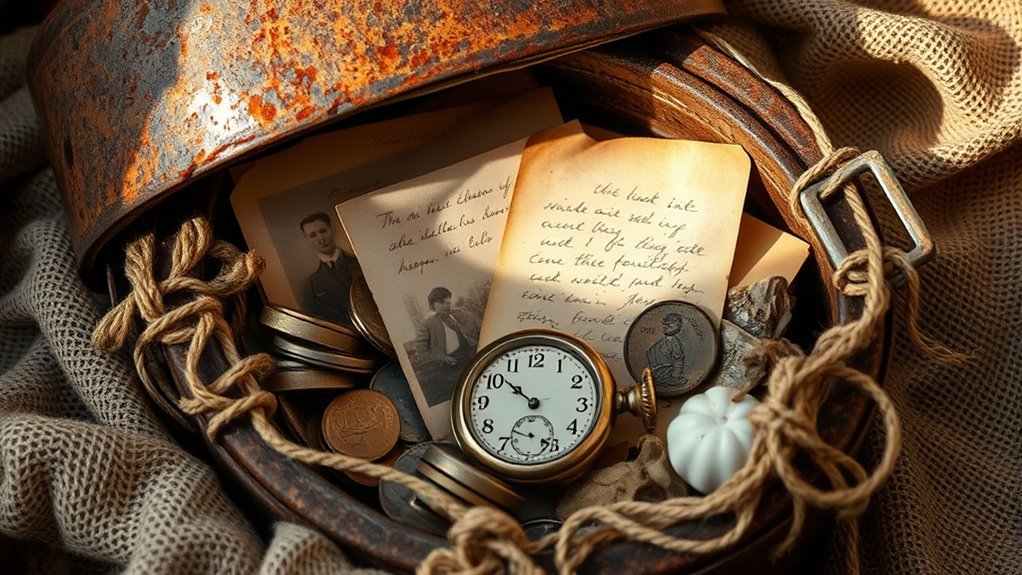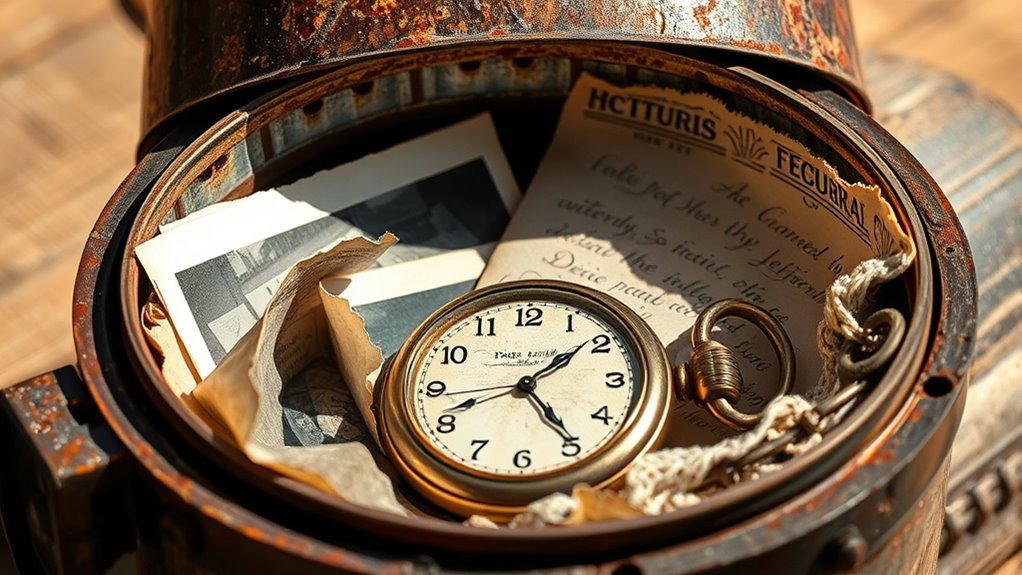When a century-old time capsule is opened, you get a fascinating glimpse into everyday life from the past. It contains letters, photographs, and small objects like pocket watches or toys that tell stories of previous generations. Experts carefully preserve these artifacts to keep their original condition, making sure history remains intact. If you keep exploring, you’ll uncover how these treasures connect us across time and what they reveal about life long ago.
Key Takeaways
- The time capsule, recently unearthed beneath a small town, contains artifacts dating back over a century that showcase daily life from the past.
- Contents include letters, photographs, and small objects like a pocket watch and toy, offering insights into historical routines and culture.
- Experts carefully handled the artifacts using preservation techniques that control temperature and humidity to prevent deterioration.
- Preserving these items maintains their cultural significance and ensures they remain authentic for future study and appreciation.
- The discovery creates a tangible link between generations, highlighting the importance of respectful conservation of historical objects.

Hidden beneath the surface of a quiet town, a century-old time capsule was recently uncovered, offering a fascinating glimpse into the past. As you stand there, you realize that what’s inside could change your understanding of everyday life from a bygone era. When the capsule was carefully excavated, experts knew they’d find a collection of historical artifacts that could tell stories no history book could fully capture. These artifacts—letters, photographs, small objects—are tangible connections to people who lived long before your time. You’re invited to imagine the stories behind each one, preserved through the years.
Opening the capsule requires delicate preservation techniques. You watch as specialists handle the fragile items with utmost care, knowing that even the slightest mistake could damage these priceless pieces of history. Modern preservation methods are vital here—they involve controlling temperature, humidity, and light to slow down the natural deterioration process. These techniques guarantee that these artifacts remain as close to their original state as possible, allowing future generations to study and appreciate them. It’s a meticulous process, blending science and history, and you’re struck by the precision needed to keep these treasures intact. Proper preservation techniques are essential to maintain the integrity of historical objects and prevent irreversible damage.
Specialists carefully handle fragile artifacts using controlled environments to preserve their original condition for future study.
Inside, you see a variety of objects that reveal what daily life was like a hundred years ago. There might be a pocket watch, a handwritten letter, or a small toy—all items that give you a window into the past. As you observe, you realize that these artifacts weren’t just kept for their material value; they’re carriers of stories, memories, and cultural significance. Each piece was carefully placed in the capsule with the hope that future generations would unearth it and learn about the lives of those who came before. Additionally, sound design techniques could be employed to recreate the ambient atmosphere of that era, providing a richer sensory experience for future audiences.
The preservation techniques used to safeguard these items are as important as the artifacts themselves. They prevent decay and guarantee that the history within remains accessible. Without proper care, these objects could have faded into obscurity, lost forever to time and the elements. Now, thanks to these methods, you’re witnessing history preserved in a way that’s both respectful and scientifically sound. This careful process echoes the importance of sound preservation in maintaining the integrity and authenticity of historical audio and visual records for generations to come.
As you reflect on this discovery, you realize that the time capsule is more than just a container of old objects. It’s a bridge across generations, a tangible link to the past that’s been carefully preserved for the future. And as you leave, you carry with you a newfound appreciation for the delicate balance of preserving history and the stories that these artifacts continue to tell.
Frequently Asked Questions
Who Originally Sealed the Time Capsule?
You might wonder who originally sealed the time capsule, and it was likely a group of community leaders or students from the early 20th century. They used a sealing method involving metal and concrete to guarantee preservation. In the historical context, sealing the capsule aimed to protect artifacts for future generations, reflecting the era’s sense of optimism and hope for posterity. Their effort preserved a snapshot of daily life for today’s discovery.
Were There Any Unexpected or Unusual Items Found Inside?
You might think opening a time capsule would reveal ordinary items, but surprisingly, unexpected discoveries await. Among the unusual artifacts are strange trinkets and peculiar documents that defy expectations. These unexpected finds add a layer of mystery and humor to the discovery, proving that even in something as mundane as a time capsule, you can stumble upon surprises that challenge your assumptions about the past. It’s a reminder that history often holds more than meets the eye.
How Was the Capsule Preserved Over the Decades?
You might wonder how the capsule stayed intact over the decades. Preservation techniques like sealing it tightly and using corrosion-resistant materials helped prevent material degradation. These methods slowed down decay caused by moisture, air, and temperature changes. By carefully choosing durable materials and maintaining a stable environment, the capsule preserved its contents, allowing you to glimpse the past without the items succumbing to time’s effects.
Will the Artifacts Be Displayed Publicly or Kept Private?
You wonder if the artifacts will be part of a museum exhibition or stay in a private collection. While some treasures might be displayed publicly to share history, others could remain private, kept away from curious eyes. This contrast highlights how history can be both accessible and protected, depending on decisions made. Either way, the choice influences how future generations experience and learn from these priceless pieces of the past.
Are There Plans to Create a Replica of the Capsule?
You’re curious if a replica of the capsule will be made. Yes, museum exhibits and replica projects are often part of preserving history. Creating a replica allows visitors to engage with the past in a tangible way, enhancing educational experiences. The museum may plan to develop a detailed replica to showcase alongside the original artifacts, giving people a chance to better understand daily life from that era and ensuring the history remains accessible.
Conclusion
As you hold these treasures from a century ago, it’s fascinating to realize that over 90% of the items still reveal daily life’s details so clearly. This time capsule offers a rare glimpse into the past, connecting you to people who lived a hundred years ago. It’s incredible to think that a simple object, like a pocket watch or a handwritten letter, can tell such a vivid story, bridging generations in just a moment.









